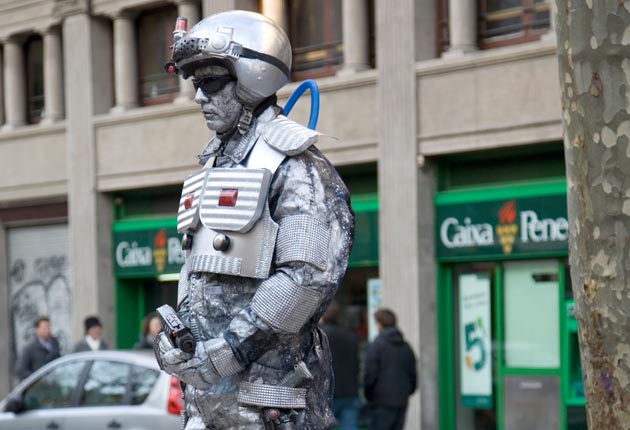Barcelona takes a stand against its 'living statues'

They are known as "living statues" – street performers who cover themselves in body paint or flowing cloaks reminiscent of stone goddesses, kings and thinkers.
They strike eternal poses; they do not blink or scratch (unless you catch them off duty with a sandwich or cigarette). If a passer-by drops a coin, they might wink or offer a slight wave.
For many city dwellers, these immobile acts have already become invisible, part of the urban scenery. But for residents of Barcelona's famed pedestrian walkway, The Rambla, they are all too visible – in fact, the glut of petrified mimes is causing traffic jams. To keep the crowds moving, the city council has decided to regulate the statues standing frozen on the thoroughfare at the heart of Barcelona's medieval quarter that attracts 200,000 visitors a day, or 78 million people per year.
"Often a crowd gathers around a human statue in the narrowest parts and you can't pass by," said Xavi Masip, of the Association of Friends, Neighbours and Merchants of The Rambla. "Everything comes to a standstill."
From 1 January, the council will designate only 15 "living statue" posts along The Rambla, with two fixed turns, morning and evening, for each. Mimes will be required to compete for the positions by submitting a CV or portfolio to officials. Thirty winners will be given an identity card certifying their official statue status, and time slots will be awarded in a lottery.
"The number of statues cannot be unlimited. It is necessary to have some minimal artistic criteria," said Assumpta Escarp, who represents the historic city centre, Ciutat Vella, on the council. "Without control, we have seen situations where there has been brutal and abusive occupation of public space." Traffic is not the only problem. The Rambla's neighbours are also concerned with aesthetics, especially now that the historic pathway that inspired writers from Lorca to Hemingway is a candidate for Unesco designation as a world heritage site. Without rules, the more studied artists are often edged out of the best spots by less elaborate acts.
"There are true artists with high artistic value, but we have seen a proliferation of another type that buys a costume at any old store, plants themselves in the best spots and amounts to nothing more than begging in disguise," said Mr Masip. "They are displacing the true performers."
These second-rate statues are highly organised. An entire family often passes the prime real estate from one member to the next, he added.
The Spanish Association of Living Statues could not be reached for comment. On its website, it says it opposes regulation and calls for recognition of the "specific technique and artistic discipline" of immobile actors.
"Today there are many people who believe it is easy, but it isn't," the site says. "The body hurts a great deal. You must know how to breathe in order to oxygenate the muscles properly so that lactic acid does not accumulate."
Join our commenting forum
Join thought-provoking conversations, follow other Independent readers and see their replies
Comments
Bookmark popover
Removed from bookmarks